LEXUS LS430 2003 Factory Repair Manual
Manufacturer: LEXUS, Model Year: 2003, Model line: LS430, Model: LEXUS LS430 2003Pages: 4500, PDF Size: 87.45 MB
Page 1911 of 4500
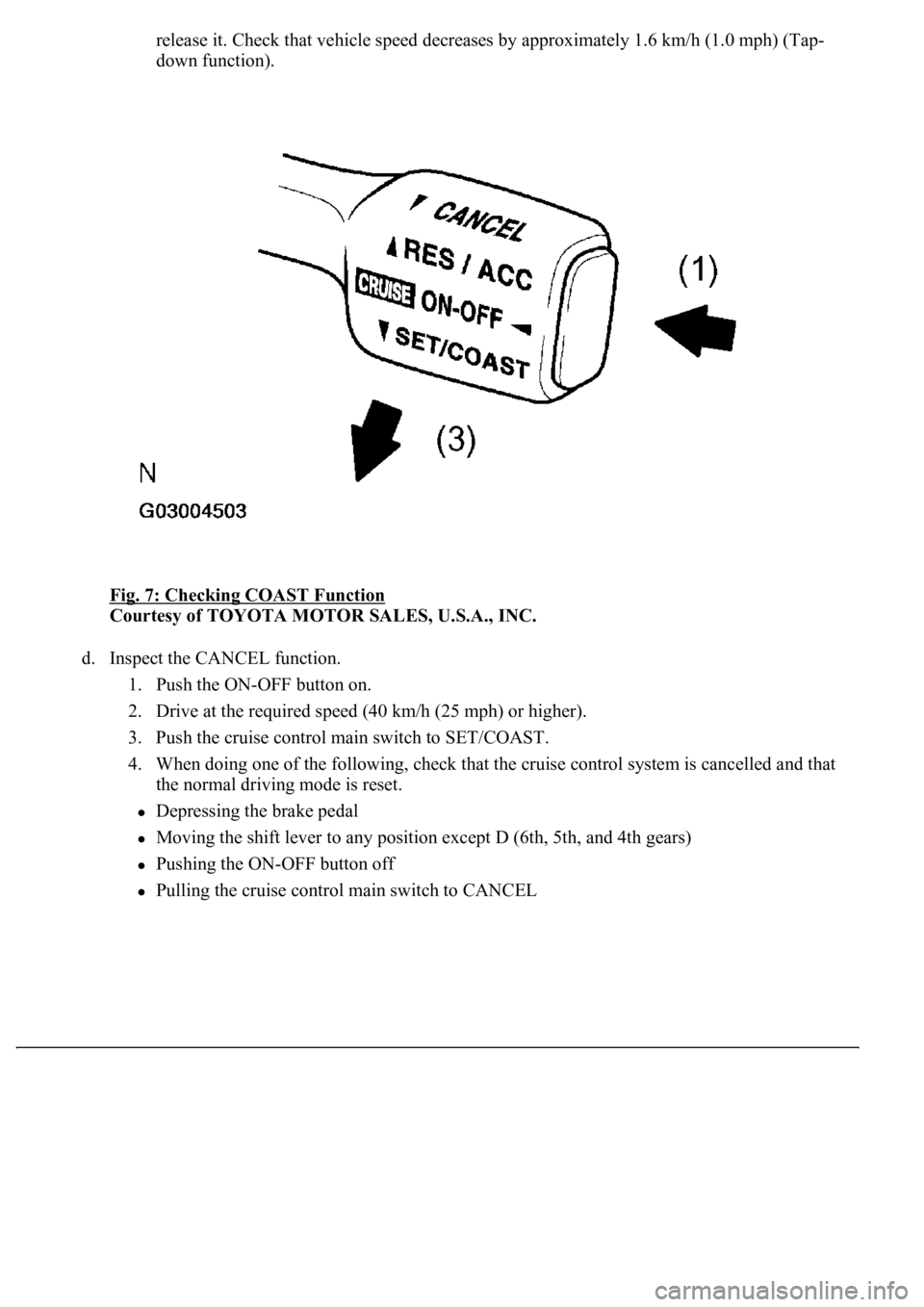
release it. Check that vehicle speed decreases by approximately 1.6 km/h (1.0 mph) (Tap-
down function).
Fig. 7: Checking COAST Function
Courtesy of TOYOTA MOTOR SALES, U.S.A., INC.
d. Inspect the CANCEL function.
1. Push the ON-OFF button on.
2. Drive at the required speed (40 km/h (25 mph) or higher).
3. Push the cruise control main switch to SET/COAST.
4. When doing one of the following, check that the cruise control system is cancelled and that
the normal driving mode is reset.
Depressing the brake pedal
Moving the shift lever to any position except D (6th, 5th, and 4th gears)
Pushing the ON-OFF button off
Pulling the cruise control main switch to CANCEL
Page 1912 of 4500
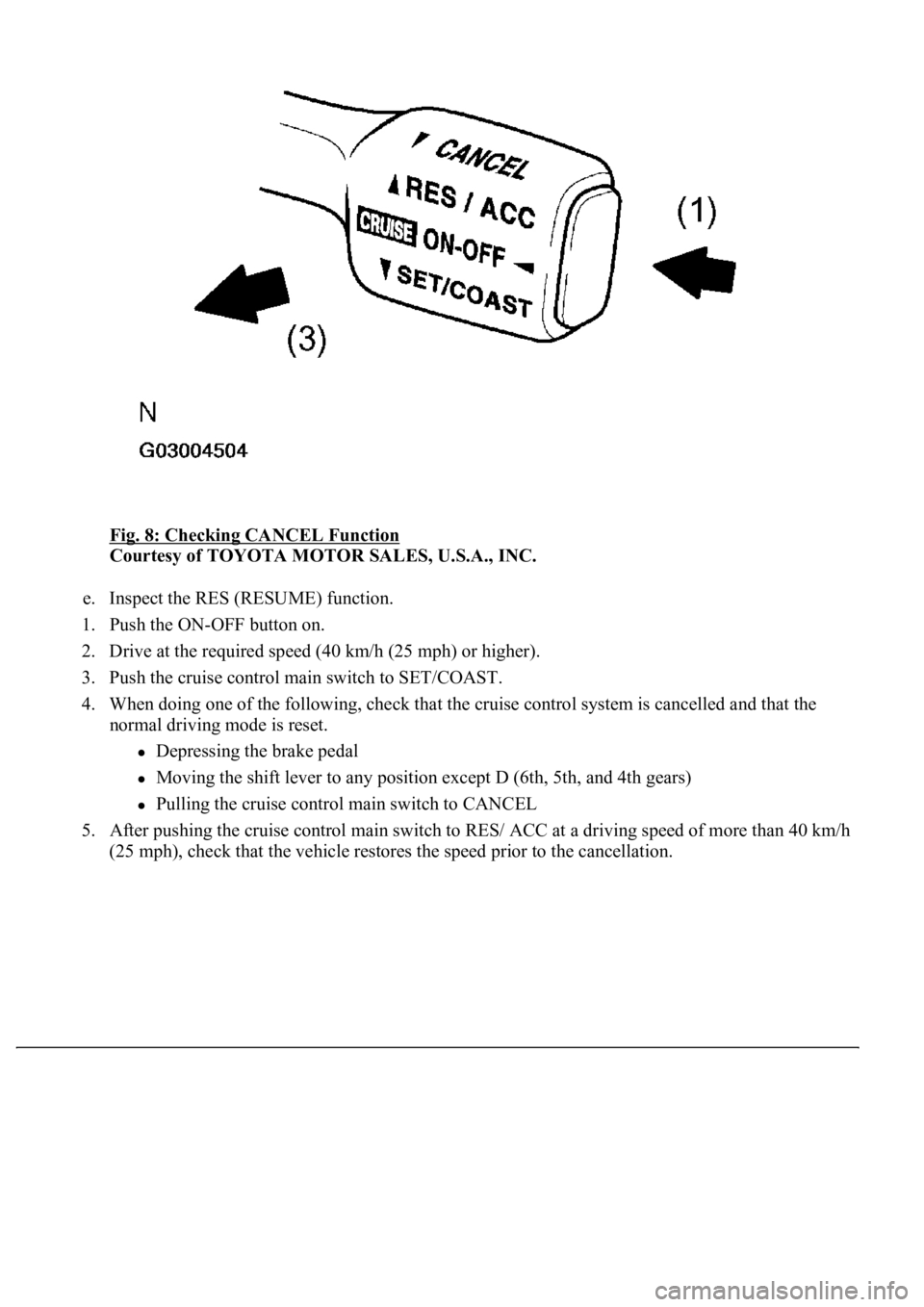
Fig. 8: Checking CANCEL Function
Courtesy of TOYOTA MOTOR SALES, U.S.A., INC.
e. Inspect the RES (RESUME) function.
1. Push the ON-OFF button on.
2. Drive at the required speed (40 km/h (25 mph) or higher).
3. Push the cruise control main switch to SET/COAST.
4. When doing one of the following, check that the cruise control system is cancelled and that the
normal driving mode is reset.
Depressing the brake pedal
Moving the shift lever to any position except D (6th, 5th, and 4th gears)
Pulling the cruise control main switch to CANCEL
5. After pushing the cruise control main switch to RES/ ACC at a driving speed of more than 40 km/h
(25 mph), check that the vehicle restores the speed prior to the cancellation.
Page 1913 of 4500
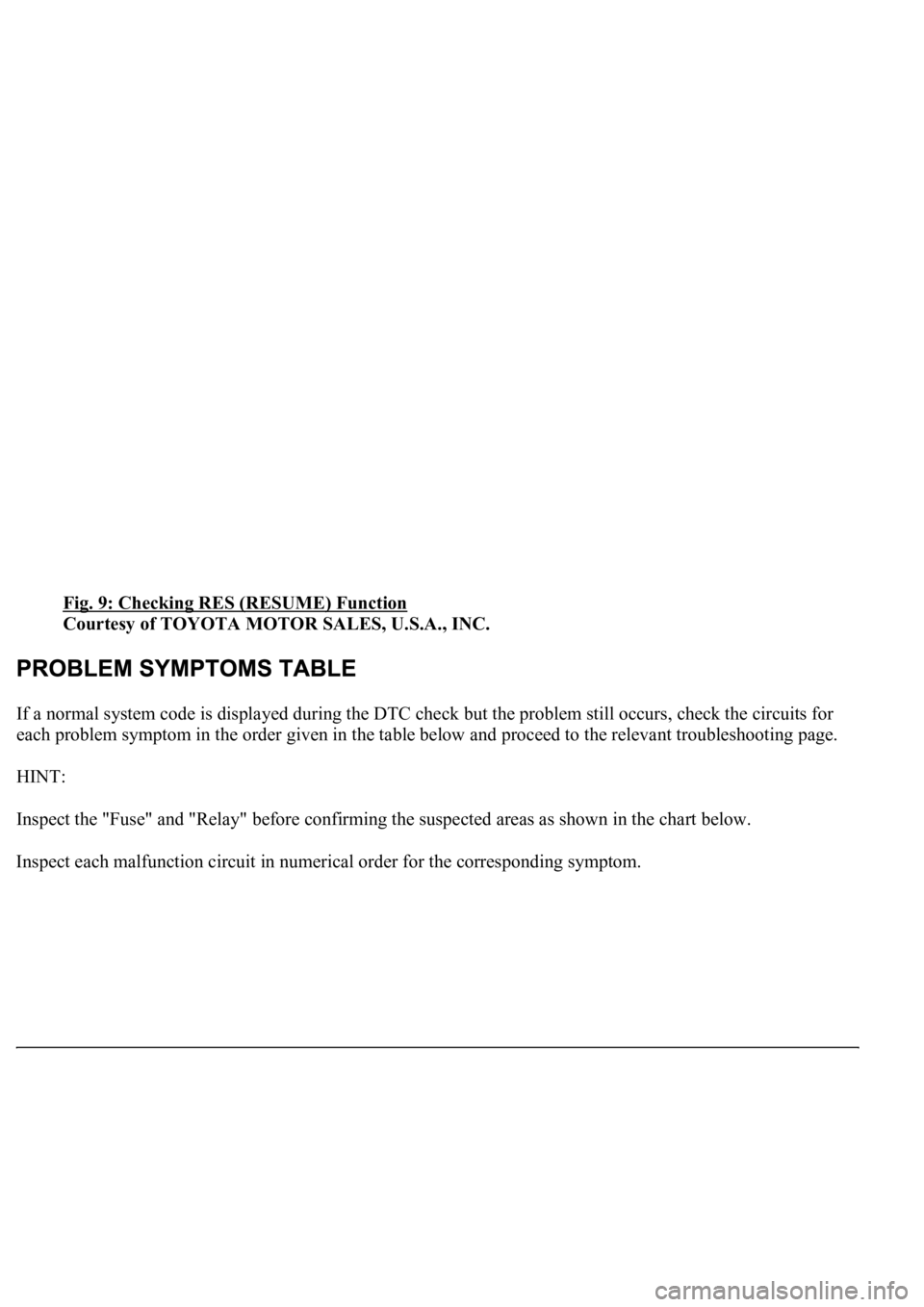
Fig. 9: Checking RES (RESUME) Function
Courtesy of TOYOTA MOTOR SALES, U.S.A., INC.
If a normal system code is displayed during the DTC check but the problem still occurs, check the circuits for
each problem symptom in the order given in the table below and proceed to the relevant troubleshooting page.
HINT:
Inspect the "Fuse" and "Relay" before confirming the suspected areas as shown in the chart below.
Inspect each malfunction circuit in numerical order for the correspondin
g symptom.
Page 1914 of 4500
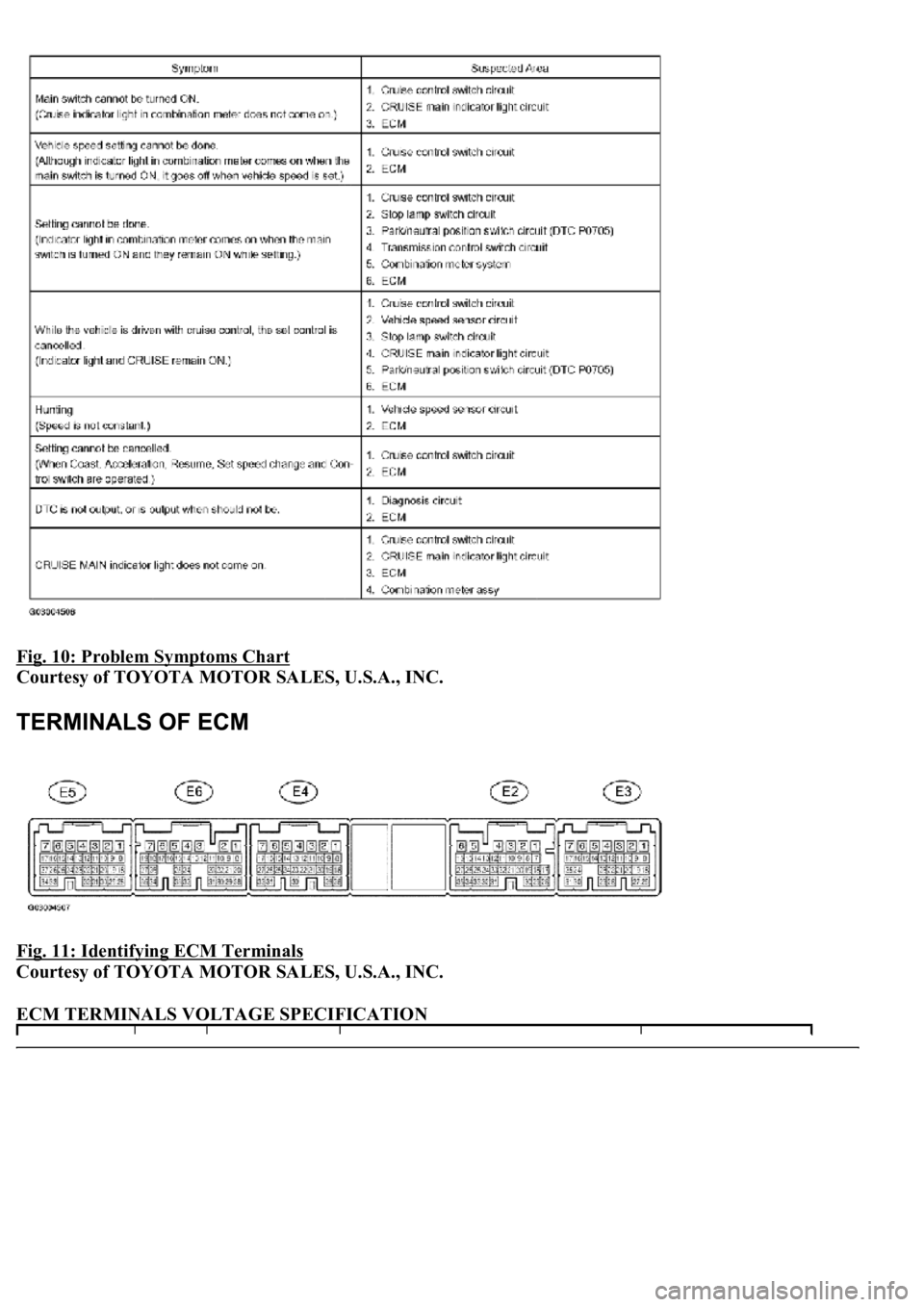
Fig. 10: Problem Symptoms Chart
Courtesy of TOYOTA MOTOR SALES, U.S.A., INC.
Fig. 11: Identifying ECM Terminals
Courtesy of TOYOTA MOTOR SALES, U.S.A., INC.
ECM TERMINALS VOLTAGE SPECIFICATION
Page 1915 of 4500
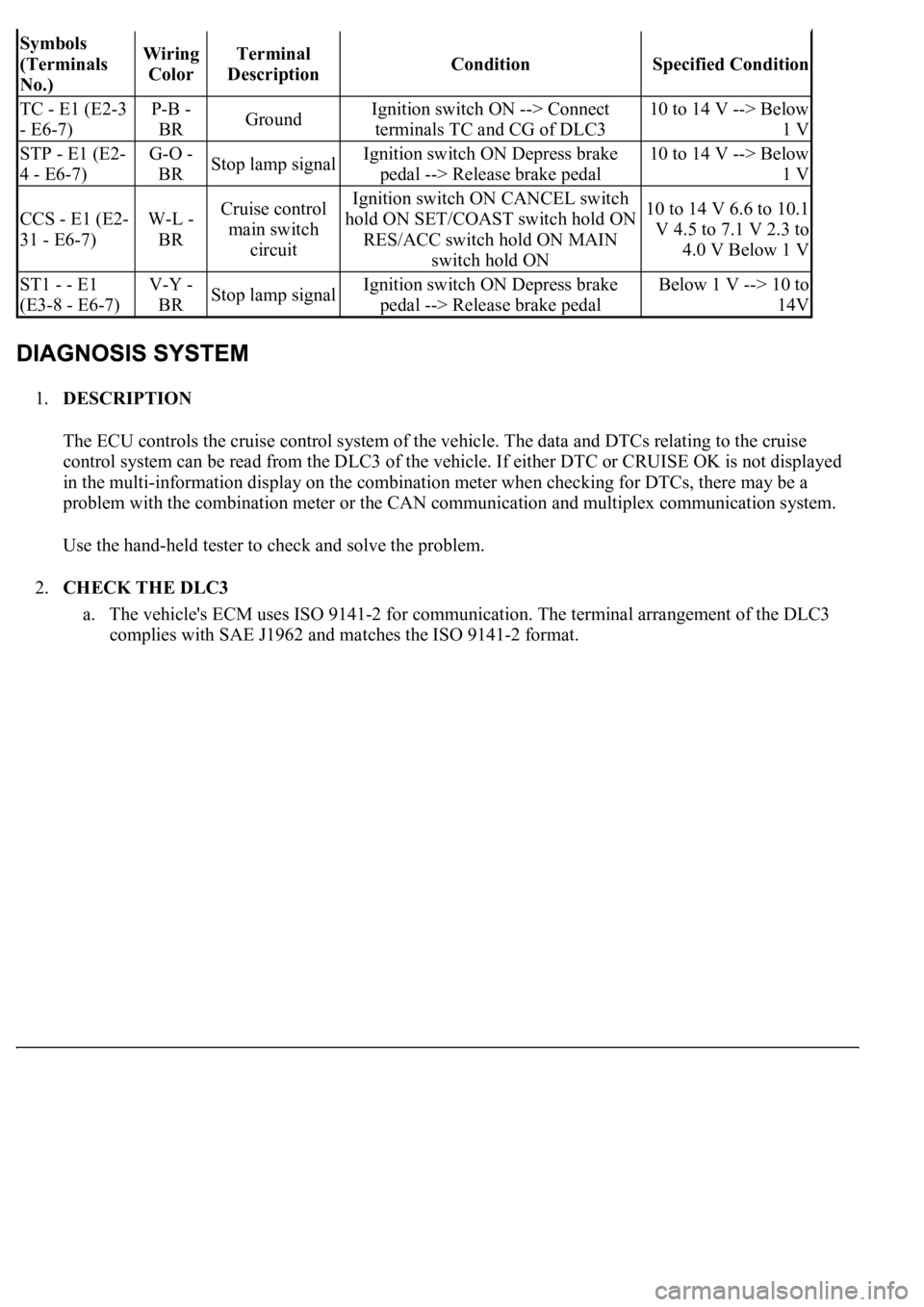
1.DESCRIPTION
The ECU controls the cruise control system of the vehicle. The data and DTCs relating to the cruise
<004600520051005700550052004f00030056005c00560057004800500003004600440051000300450048000300550048004400470003004900550052005000030057004b004800030027002f0026001600030052004900030057004b004800030059004800
4b004c0046004f004800110003002c004900030048004c0057[her DTC or CRUISE OK is not displayed
in the multi-information display on the combination meter when checking for DTCs, there may be a
problem with the combination meter or the CAN communication and multiplex communication system.
Use the hand-held tester to check and solve the problem.
2.CHECK THE DLC3
a. The vehicle's ECM uses ISO 9141-2 for communication. The terminal arrangement of the DLC3
complies with SAE J1962 and matches the ISO 9141-2 format.
Symbols
(Terminals
No.)Wiring
ColorTerminal
DescriptionConditionSpecified Condition
TC - E1 (E2-3
- E6-7)P-B -
BRGroundIgnition switch ON --> Connect
terminals TC and CG of DLC310 to 14 V --> Below
1 V
STP - E1 (E2-
4 - E6-7)G-O -
BRStop lamp signalIgnition switch ON Depress brake
pedal --> Release brake pedal10 to 14 V --> Below
1 V
CCS - E1 (E2-
31 - E6-7)W-L -
BRCruise control
main switch
circuitIgnition switch ON CANCEL switch
hold ON SET/COAST switch hold ON
RES/ACC switch hold ON MAIN
switch hold ON10 to 14 V 6.6 to 10.1
V 4.5 to 7.1 V 2.3 to
4.0 V Below 1 V
ST1 - - E1
(E3-8 - E6-7)V-Y -
BRStop lamp signalIgnition switch ON Depress brake
pedal --> Release brake pedalBelow 1 V --> 10 to
14V
Page 1916 of 4500
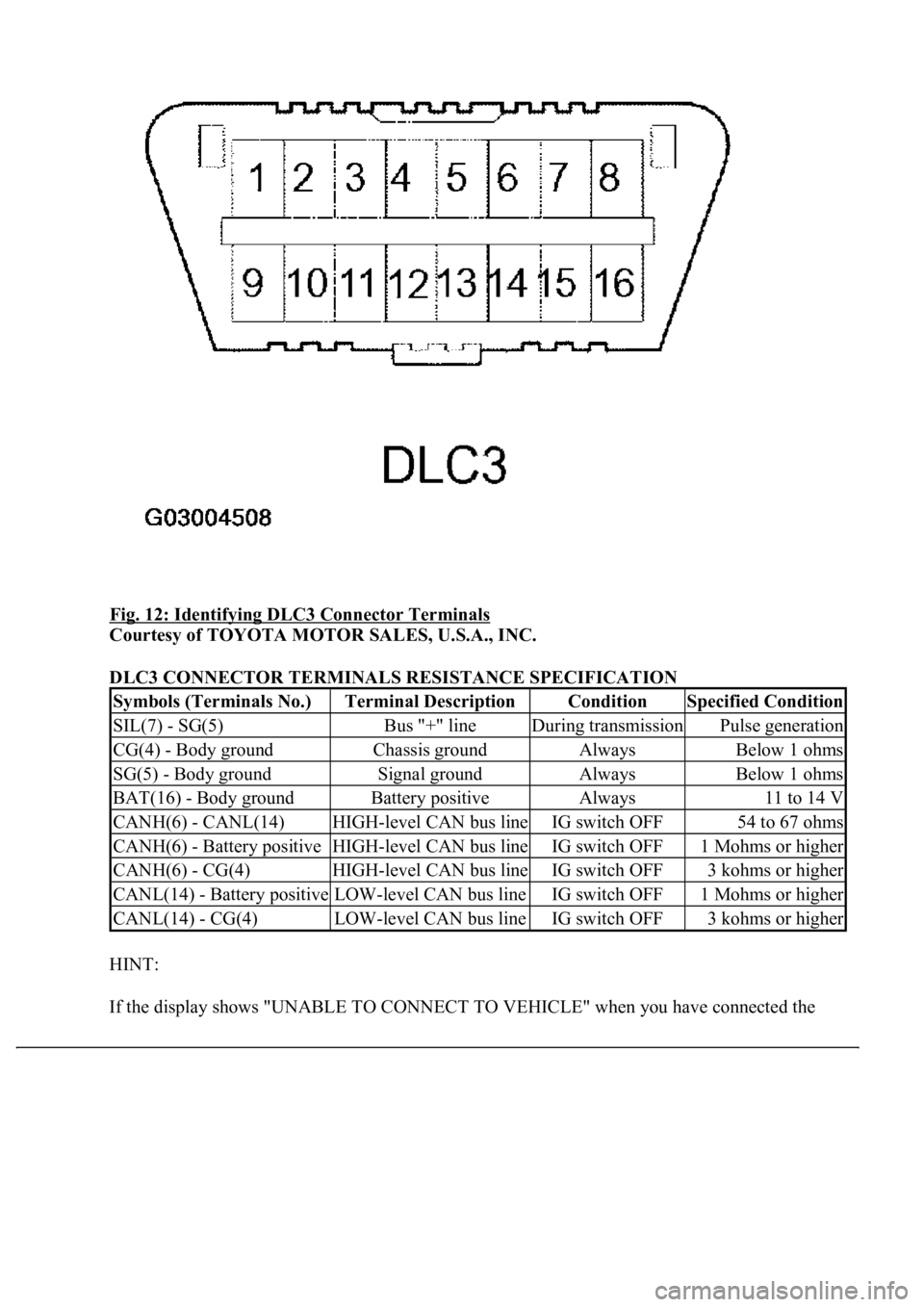
Fig. 12: Identifying DLC3 Connector Terminals
Courtesy of TOYOTA MOTOR SALES, U.S.A., INC.
DLC3 CONNECTOR TERMINALS RESISTANCE SPECIFICATION
HINT:
If the displa
y shows "UNABLE TO CONNECT TO VEHICLE" when you have connected the
Symbols (Terminals No.)Terminal DescriptionConditionSpecified Condition
SIL(7) - SG(5)Bus "+" lineDuring transmissionPulse generation
CG(4) - Body groundChassis groundAlwaysBelow 1 ohms
SG(5) - Body groundSignal groundAlwaysBelow 1 ohms
BAT(16) - Body groundBattery positiveAlways11 to 14 V
CANH(6) - CANL(14)HIGH-level CAN bus lineIG switch OFF54 to 67 ohms
CANH(6) - Battery positiveHIGH-level CAN bus lineIG switch OFF1 Mohms or higher
CANH(6) - CG(4)HIGH-level CAN bus lineIG switch OFF3 kohms or higher
CANL(14) - Battery positiveLOW-level CAN bus lineIG switch OFF1 Mohms or higher
CANL(14) - CG(4)LOW-level CAN bus lineIG switch OFF3 kohms or higher
Page 1917 of 4500
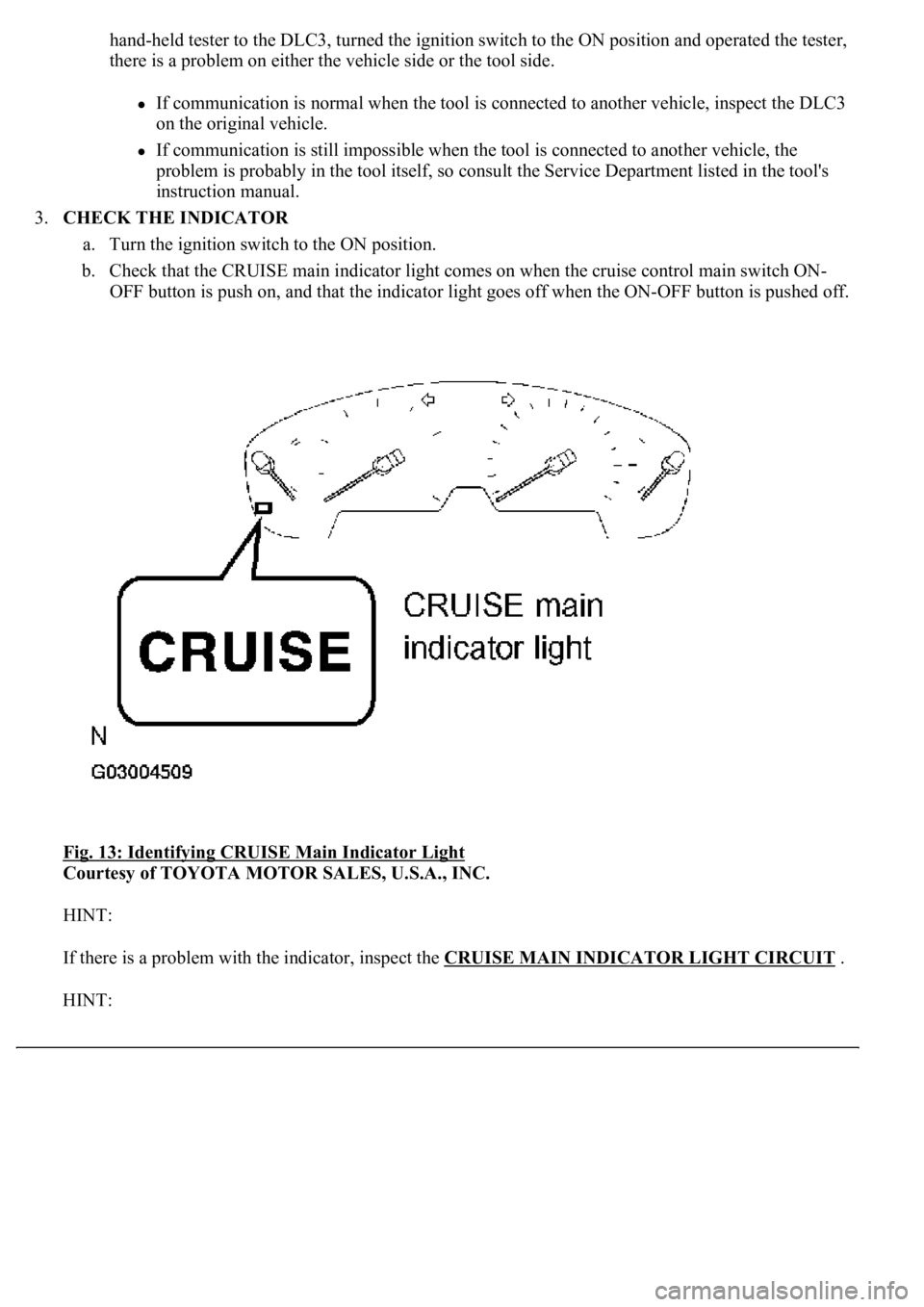
hand-held tester to the DLC3, turned the ignition switch to the ON position and operated the tester,
there is a problem on either the vehicle side or the tool side.
If communication is normal when the tool is connected to another vehicle, inspect the DLC3
on the original vehicle.
If communication is still impossible when the tool is connected to another vehicle, the
problem is probably in the tool itself, so consult the Service Department listed in the tool's
instruction manual.
3.CHECK THE INDICATOR
a. Turn the ignition switch to the ON position.
b. Check that the CRUISE main indicator light comes on when the cruise control main switch ON-
OFF button is push on, and that the indicator light goes off when the ON-OFF button is pushed off.
Fig. 13: Identifying CRUISE Main Indicator Light
Courtesy of TOYOTA MOTOR SALES, U.S.A., INC.
HINT:
If there is a problem with the indicator, inspect the CRUISE MAIN INDICATOR LIGHT CIRCUIT
.
HINT:
Page 1918 of 4500
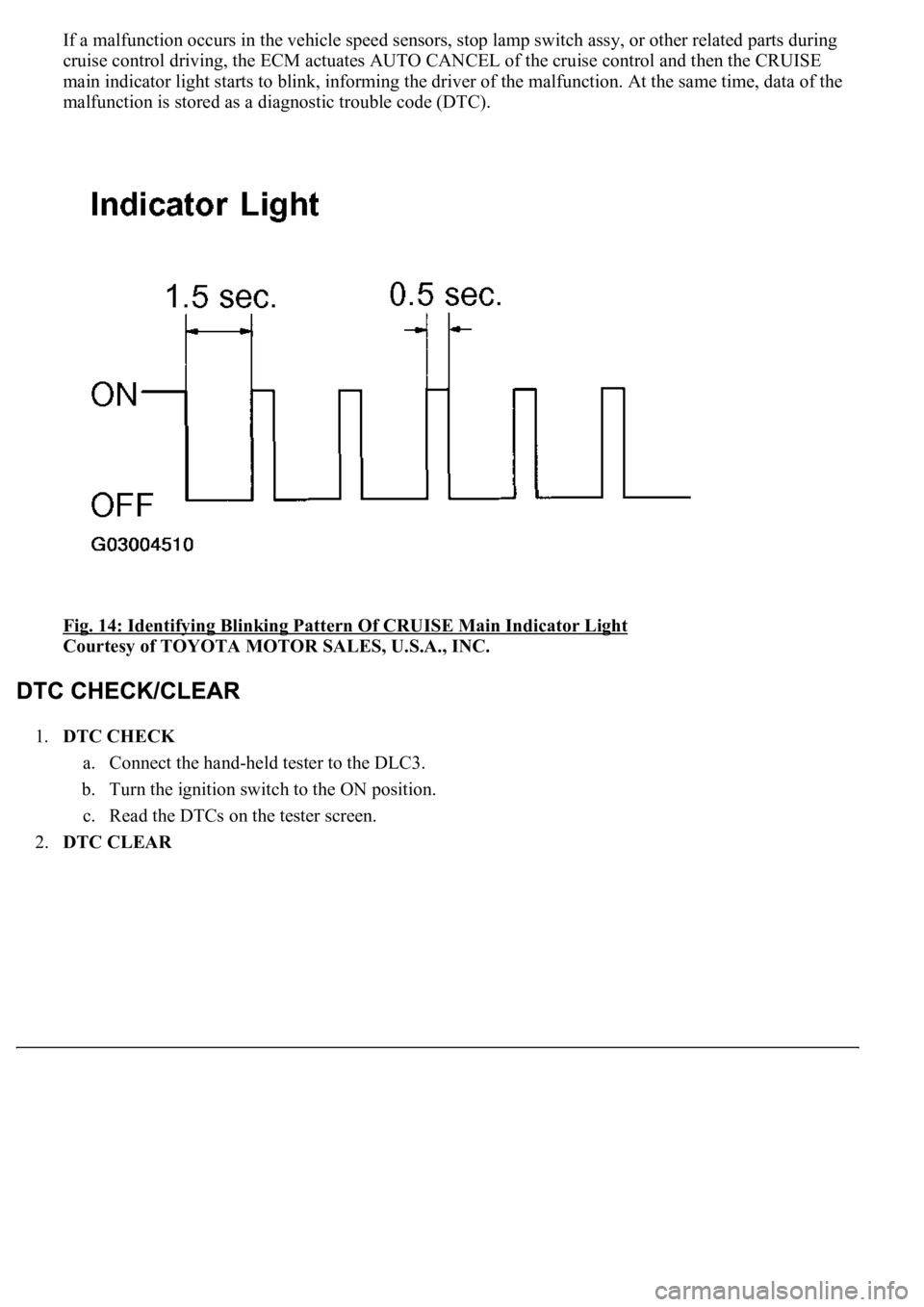
If a malfunction occurs in the vehicle speed sensors, stop lamp switch assy, or other related parts during
cruise control driving, the ECM actuates AUTO CANCEL of the cruise control and then the CRUISE
main indicator light starts to blink, informing the driver of the malfunction. At the same time, data of the
malfunction is stored as a diagnostic trouble code (DTC).
Fig. 14: Identifying Blinking Pattern Of CRUISE Main Indicator Light
Courtesy of TOYOTA MOTOR SALES, U.S.A., INC.
1.DTC CHECK
a. Connect the hand-held tester to the DLC3.
b. Turn the ignition switch to the ON position.
c. Read the DTCs on the tester screen.
2.DTC CLEAR
Page 1919 of 4500

Fig. 15: Connecting Hand-Held Tester To DLC3
Courtesy of TOYOTA MOTOR SALES, U.S.A., INC.
a. Connect the hand-held tester to the DLC3.
b. Turn the ignition switch to the ON position.
c. Clear the DTCs following the prompts on the tester screen.
1.If the following conditions are detected while the cruise control is in operation, the system clears the
stored vehicle speed in the ECM and cancels the cruise control operation.
Page 1920 of 4500

Fig. 16: Fail-Safe Chart
Courtesy of TOYOTA MOTOR SALES, U.S.A., INC.
1.DATA LIST
a. While the hand-held tester is connected to the DLC3 and with the ignition switch turned to the ON
position, the CRUISE CONTROL data list can be displayed. Follow the prompts on the tester
screen to access the data list.
DATA LIST (CC (ECM))
Item
Measurement Item / Display
(Range)
Normal ConditionDiagnostic Note
VEHICLE SPDVehicle speed / min.: 0 km/h (0
mph), max.: 255 km/h (158
mph)Actual vehicle speed-
MEMORY SPDCruise control memorized
speed / min.: 0 km/h (0 mph),
max.: 255 km/h (158 mph)Actual stored vehicle speed-
THROTTLERequired throttle opening angle /
min.: 0°, max.: 125°Actual required throttle opening-
CRUISE CTRLCruise control system active
condition / ON or OFFON: Cruise control activated
OFF: Cruise control inactivated-
MAIN SW
(MAIN)Main SW signal (Main CPU) /
ON or OFFON: Main SW ON (Pushed on)
OFF: Main SW OFF (Pushed
off)"3"
MAIN SW (SUB)Main SW signal (Sub CPU) /
ON or OFFON: Main SW ON (Pushed on)
OFF: Main SW OFF (Pushed
off)"3"
CCS READY MCruise control system standby
condition (Main CPU) / ON or
OFFON --> OFF: Change ON/OFF
each time Main SW is pushed in."1"